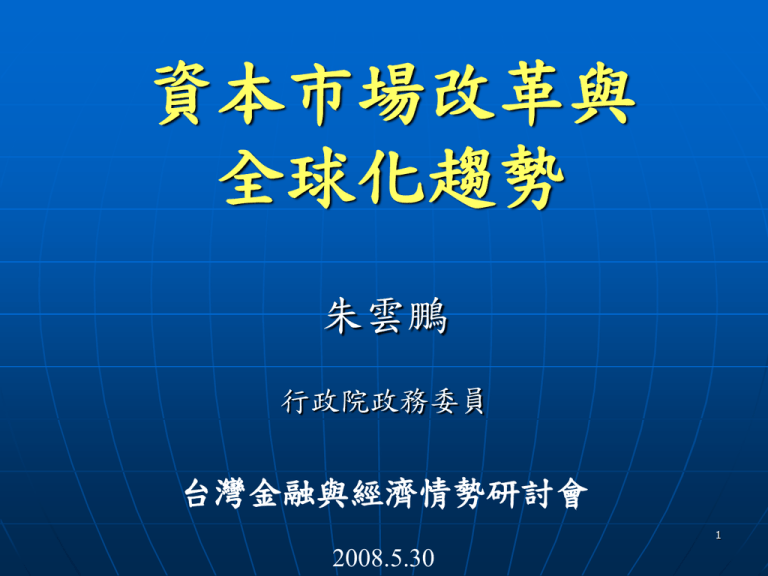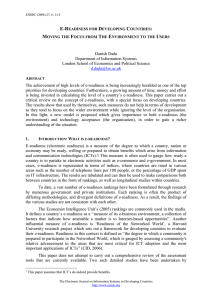1 1
advertisement

資本市場改革與 全球化趨勢 朱雲鵬 行政院政務委員 台灣金融與經濟情勢研討會 1 2008.5.30 Outlines I Globalization of the financial sector II Review of the development of Taiwan’s capital market and the financial industry III Challenges IV Responses 2 I. Globalization of the financial sector A. “Get global, get specialized, or get out“ B. The “Big Bang” C. Financial centers are booming. D. Global investment banks are ever more aggressive. E. US capital market is losing its competitiveness. 3 A.Get global. Get Specialized. Or get out. Unexpected lessons in global financial markets IBM Global Business Service, 2007 In collaboration with the Economist Intelligence unit, this IBM report develops and uses a model and have used it to trace the effect of globalization across 35 of the world’s largest economies. The report also surveyed 848 financial markets executives from around the globe and 107 of their corporate clients. 4 Summary of Findings Financial markets firms have historically avoided the commoditization trap by innovating to create new products and services; the bulk of their impressive growth has typically come from mature markets. Yet today, growth opportunities in those geographies are evaporating, and meaningful future expansion will come from new markets. Indeed, the worldwide industry opportunity is expected to double by 2015. But which firms will seize these emerging profit pools? The report believes it will be those that specialize in the areas their clients value while optimizing their global reach, and do both in ways that aren’t expected. 5 Source: IBM Global Business Service, 2007. 6 7 Source: IBM Global Business Service, 2007 Key Element to Success or Failure 1: Talents 8 Source: IBM Global Business Service, 2007 Key Element 2: IT infrastructure For a robust financial market, economies must also have the vital information and communications technology infrastructure. According to annual e-readiness rankings of the world’s 35 largest economies, global e-readiness grew at a 7-percent CAGR from 2001 to 2006, which is faster that worldwide GDP. On a scale of one to five, worldwide e-readiness was judged to be 3.27, largely led by developed markets. At the top of the scale were Switzerland (4.9), the United Kingdom (4.8) and the United States (4.6). India fell in the middle of the pack at 3.1. And China (2.6), Ukraine (2.6), Russia (2.4) and Iran (1.7) ranked lowest. 9 Key Element 3: Trading Volume Economies must also have a sizable liquidity pool to support continued future growth of the capital markets. Based on our analysis of velocity, the ratio of trading volume to market capitalization over the past ten years, it is clear that liquidity is increasing globally. In 1995, the ratio for Europe, the Middle East and Africa was under 70 percent; but by 2005, it had more than doubled to 145 percent. Asia’s ratio grew from 41 percent in 1995 to 75 percent in 2005. And even with a much higher overall volume of trading, the Americas’ ratio increased from 75 percent in 1995 to nearly 130 percent as of 2005. This level of growth presents an opportunity for broker dealers in particular, as they realize higher revenues 10 based on velocity increases across the geographies. Source: IBM Global Business Service, 2007 11 B. The “Big Bang” UK 1986 (London Stock Exchange): abolishing the fixed commission charges system, more open to the international players and a change from open-outcry to electronic, screen-based trading (Stock Exchange Automated Quotation system or SEAQ). UK 1997: passage of the Financial Service and Market Act, which combines jurisdiction of agencies for banks, securities, insurance, futures,… into a single Financial Services Authority. 12 Background of the London’s Big Bang The relative decline of the status of the British securities market In 1985, before the implementation of the "Big Bang," the London stock exchange's turnover was only 1/13 of the then world's No. 1 New York, and it was only 1/5 of the No. 2 Tokyo. 13 Reforms in October 1986 (1) Firms were permitted to act as both jobbers and brokers— two categories that had previously been strictly segregated (2) The opening up of membership of the stock exchange (3) The lowering of the 1% tax on share transactions—the equivalent of Japan’s securities transaction tax—to 0.5%. 14 Achievement after Reforms (1) Industrial Effects While the ratio the financial sector occupies in UK's GDP was 13.6% in 1985 before the "Big Bang", it had risen to 17.2% in 1990, after the "Big Bang. (2) Competitiveness of Commissions Commission ratios on the whole achieved a standard that was relatively low by the international standard. (3) International Position Capital of securities firms was strengthened in general. London became the center of European investment banking. 15 Japan 1996: The Financial Services Agency Created Japan 1998-2001: The Big Bang package is a complex series of measures (contained in a 2,132-page volume), staggered from April 1, 1998 to March 2001. The first liberalization removes barriers to companies buying and selling, and offering investments, in foreign currencies. By 2001 it will be theoretically possible for Japanese and overseas-owned institutions alike to perform banking, insurance, stock brokering and investment services in yen or any other currency, with minimal government regulation. "Japan is not doing enough," stated Frank Hesske, minister-counselor and deputy head of deregulation for the European Commission in Japan. US Trade Representative Charlene Barshefsky had an even more negative view. "The new deregulation program is too vague on key issues and often delays implementation of important regulatory changes for several years," she said. (Source: Mike Head, the 4th 16 International) C. Financial Centers are Booming London, New York and Hong Kong are the world's top three financial centers according to Economist. Key factors: 1. Plenty of skilled people 2. Ready access to capital 3. Good infrastructure 4. Attractive regulatory and tax environments and low levels of corruption 5. Location and the use of English 17 Although New York and London are pre- eminent, other big cities play important international roles of their own. Tokyo, Sydney - financial capitals of big national markets Hong Kong, Singapore and Dubai - the gateways to emerging regions Geneva - private banking Zurich and Bermuda - insurance and reinsurance Chicago - futures and options Qatar - infrastructure finance Bahrain - Islamic finance 18 There are two big changes that have encouraged the proliferation of financial centers around the globe. 1. The shift of economic activity and jobs towards China, India and other developing countries. 2. Growing demand for natural resources from the Middle East, Russia and parts of Latin America. Technology is predicted would end clustering in city centers. Armed with broadband, mobile phones and BlackBerries, financial services could work from almost anywhere. 19 D. Global investment banks are becoming ever more aggressive Commercial banks such as Citigroup and JPMorgan Chase have muscled back into investment banking. And European warhorses such as Deutsche Bank, UBS and Credit Suisse have joined the race for global supremacy. Morgan Stanley Asia(13) Europe Middle East Africa (16) UBS America (18) Asia (12) Europe (over 20) America (over 20) others 20 E. US’ capital market is losing its competitiveness The industry has been important to the US economy: The US financial services industry contains 5 percent of private sector jobs but produces 8.1 percent of GDP. The securities industry contains only 0.65 percent of private-sector employment, but is responsible for 1.4 percent of GDP. In New York City, the securities industry accounts for 4.7 percent of the jobs but 20.7 percent of total wages and 15.8 percent of nonproperty taxes. In New York State overall, this industry is responsible for 2.2 percent of the jobs, 12.5 percent of total wages, and 18.7 percent of total tax receipts. 21 But there are signs that the U.S. public equity capital market is losing competitiveness. 1. Increasing use of foreign markets. 2. Rising importance of private markets. 3. Cost of capital: an indicator of problems? 22 II Review of the development of Taiwan’s capital market and the financial industry This industry contributes 10.3 percent to Taiwan’s overall GDP in 2006 It accounts for 4 percent of the employment in the same year During the 1990s, it played a pivotal role in the rise of the IT industry which had access to vast amounts of low-cost capital for its expansion 23 III. Challenges Shrinking employment in the financial sector IPO growth stagnated Massive outflow of capital Competition with global players of investment banks in Asia (Merrill Lynch, Goldman Sachs, Morgan Stanley, HSBC, Citigroup, UBS,…etc) 24 • Shrinking employment in the financial sector Tough time ahead : Employment in Taiwan’s financial industry dropped by 0.74 percent in in 2007 compared to same period last year 410 5 4.10 400 4 就業人數(千人) 成長率 390 3 3.17 380 2 1.88 370 0.25 -0.53 360 1 -0.74 350 0 -1 2001 2002 2003 2004 2005 2006 2007 25 Source : Directorate-General of Budget, Accounting and Statistics, Executive Yuan, R.O.C 台股市值及成交值在全球交易所之排名 0 1200 1000 5 7 5 6 800 10 11 10 10 10 10 13 600 400 16 15 16 15 14 16 14 15 15 15 16 15 17 19 200 17 19 21 21 20 25 0 1996 1997 1998 1999 2000 2001 市值 成交值 2002 2003 市值排名 2004 2005 2006 2007 2008,Mar 成交值排名 26 Source: World Federation of Exchanges,台灣證券交易所整理 歷年上市(櫃)總家數趨勢變化圖 1400 上市家數 1200 上櫃家數 1092 1022 合計 1000 1194 1163 1245 1219 917 831 800 726 613 600 437 400 200 531 584 638 462 264 300 333 384 669 423 697 466 691 688 531 503 698 547 176 0 1998 1999 2000 2001 2002 2003 2004 2005 2006 2007 27 Source: 吳榮義, 「全球交易所發展趨勢與臺灣證券交易所未來展望」 近年上市IPO家數減少 2001 2002 2003 2004 2005 2006 2007 Total 紐約 144 151 107 152 146 118 126 944 那斯達克 114 121 56 170 170 156 153 940 東京 93 94 120 153 99 114 68 741 香港 88 117 73 70 67 62 84 561 韓國 16 25 20 25 113 93 98 390 新加玻 37 32 60 82 68 67 76 422 上市 70 86 47 38 13 11 30 295 上櫃 97 110 83 87 56 40 40 513 合計 167 196 130 125 69 51 70 808 台灣 Source: World Federation of Exchanges 28 Number of listed companies: challenges from Hong Kong, Shanghai, Singapore 6,000 紐 約 5,000 那斯達克 倫 敦 4,000 東 京 3,000 韓 國 香 港 2,000 新加坡 1,000 0 1997 1998 1999 2000 2001 Source: Taiwan Stock Exchange 2002 2003 2004 2005 2006 2007 2008,Mar 上 海 深 圳 台 灣 29 30 Source: 吳榮義, 「全球交易所發展趨勢與臺灣證券交易所未來展望」 Massive net outflow of capital: outflow and inflow of investments in securities ( In millions of U.S. dollars) 50,000 40,000 30,000 20,000 10,000 0 -10,000 1997 1998 1999 2000 2001 2002 2003 2004 2005 2006 2007 證券投資(流出) 證券投資(流入) 31 Source : Central Bank of Republic Of China (Taiwan) IV. Responses (recommended) Laws and regulations be aligned with the needs for international competitiveness Deregulating and strengthening risk governance in securities industries Taiwan Stock Exchange becomes a publicly-traded corporation subject to global competition 32 THE END 33





